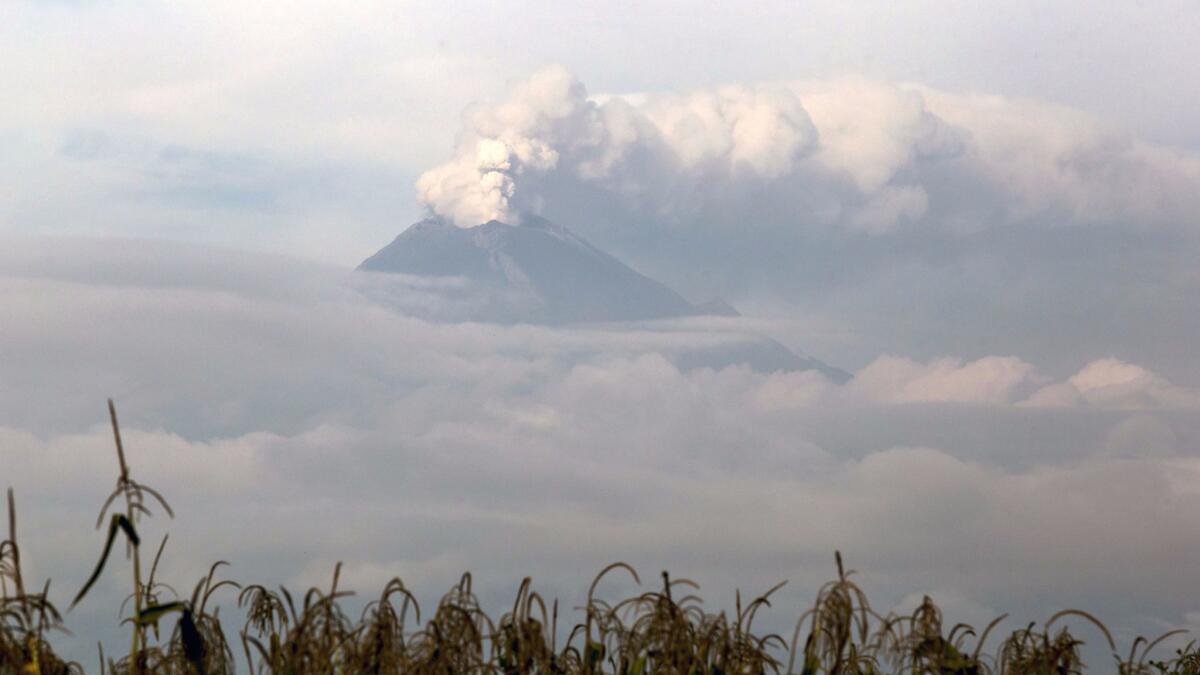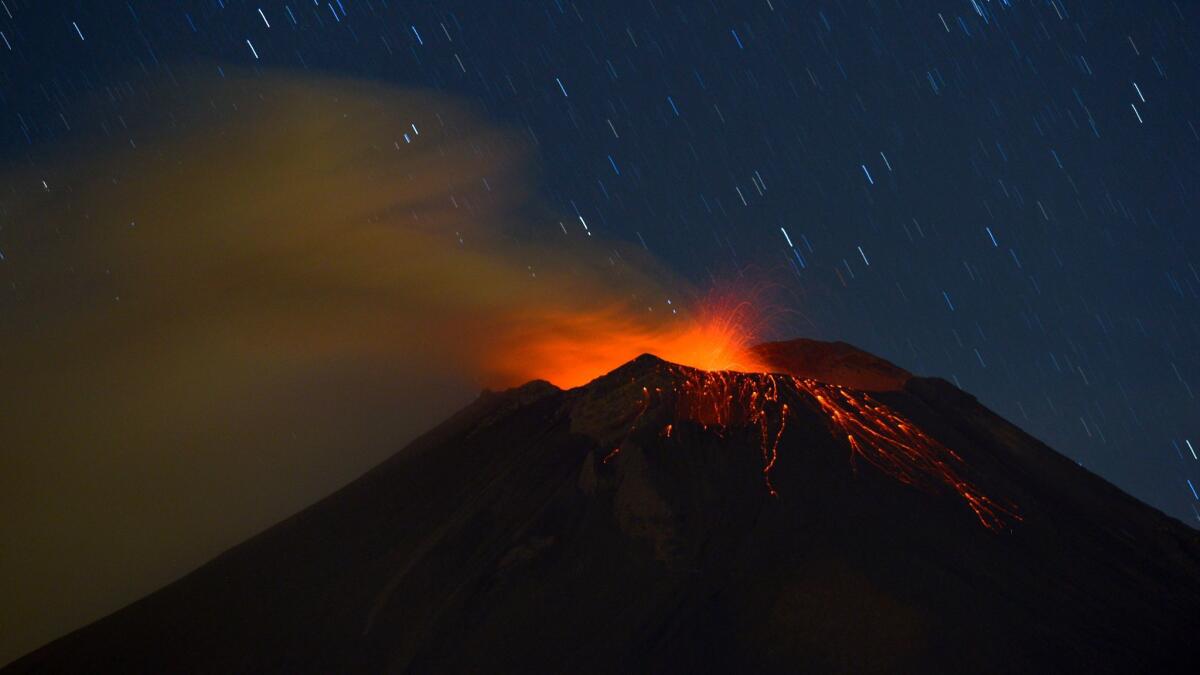This Mexican village lives under a volcano — but it’s earthquakes residents fear

- Share via
Reporting from San Antonio Alpanocan, Mexico — They live under the volcano, literally, but their fears are not focused on the latest torrents of smoke, ash and flaming stones belching from “Don Goyo” — as the Popocatepetl volcano is known in these parts, with equal measures of respect and affection, and surprisingly little dread.
“We are all accustomed to Don Goyo and his emanations, his fumarolas, his furies,” said Rosalina Rojas Garcia, 55, as she paused one recent afternoon while walking down the main drag of San Antonio Alpanocan just 10 miles from the volcano. “We have lived with Don Goyo all our lives.”
Instead it is another aspect of Mexico’s geological vulnerability — earthquakes — that drives the anxiety prevalent these days in San Antonio and other towns and hamlets hugging the signature volcano.
Media attention and rescue efforts following the powerful 7.1 earthquake that struck central Mexico on Sept. 19 focused on Mexico City, where most of the nation’s 369 fatalities were recorded. But damage also was widespread in rural areas such as San Antonio, population 3,000, and other settlements along the lush, heavily forested flanks of Popocatepetl — “smoking mountain,” in the Aztec Nahuatl language.
Though no one was killed here, about 80% of the buildings in San Antonio were destroyed or suffered extensive damage and will need to be rebuilt, officials and experts say. Volunteer groups from the nearby city of Puebla and elsewhere have hastened to provide aid amid what many residents call a desultory government response — a common complaint in earthquake-struck rural zones of Mexico.
“Popo,” a ubiquitous diminutive for the almost 18,000-foot volcano, sits less than 100 miles from the epicenter of the Sept. 19 temblor. The quake’s aftermath saw a surge in volcanic activity, including soaring plumes of smoke, vapor and ash, but authorities called the discharges normal and not a cause for alarm or evacuations.
Still, Popocatepetl is considered among nature’s most potentially lethal threats. Some 25 million people live in its vicinity, mostly in Mexico City, 40 miles northwest. Popo, Mexico’s second-highest mountain, was quiescent for more than half a century until it began to stir anew in 1994.
Popocatepetl and its relatively dormant twin, Iztaccihuatl (sometimes called la mujer dormida, or the sleeping woman, because its craggy summit bears a resemblance to a reclined female) dominate the regional landscape.
Both are intricately entwined with the pre-European worldview of the central Mexican altiplano, where volcanoes were esteemed as both deities and living beings. In one version of indigenous mythology, Popocatepetl, a mighty male warrior, and Iztaccihuatl, a princess, were an ill-starred couple who transformed after death into towering monuments, the volcanic fire symbolizing the eternal passion of their tragic romance.
Colorful images of the legendary Aztec power couple remain popular in Mexico and in Mexican American communities in the United States, where commercial calendars featuring the two grace gas stations, panaderias and other establishments. The feather-bedecked Popocatepetl is often depicted bearing the corpse of the light-skinned Iztaccihutal (roughly, “white woman” in Nahuatl), who is said to have died of a broken heart — or committed suicide — after she was misinformed that her beloved had been killed in battle.
Eruptions of Popocatepetl before the Spanish arrival in the 1500s likely caused mass evacuations of towns and ceremonial centers, scientists say. No catastrophic event has been recorded since the Spanish conquest, despite occasional evacuations.
Today, Mexican authorities closely measure Popocatepetl’s volcanic activity and seismic jolts. Webcams focus on the crater, occasionally generating sensational internet videos of volcanic bursts. Signs along roads point to emergency evacuation routes.
Early this month, Mexico’s national disaster center recorded a series of minor eruptions during the previous 24 hours on Popocatepetl, including some 200 “low-intensity exhalations” of water and gas, three explosions, three relatively small volcanic earthquakes and a light fall of ash on two towns. Authorities retained the warning level at Yellow Phase 2, meaning area residents should be alert but no danger was imminent.
“If something happens with the volcano, we know we will have a warning,” said Florencia Perez Valdez, 49, who was found on a recent Sunday outside the colonial-era church of St. Francis of Assisi, cordoned off after extensive damage in the Sept. 19 quake. “But there is no warning with an earthquake. Just the terrible shaking.”
Tears came to Perez’s eyes as she gazed at the battered church, which authorities hope to rebuild. The cast-iron bell, dated 1781, was now strung from a tree; the church bell tower collapsed in the quake.
“We have had so many important events here at the church — baptisms, funerals, marriages,” said Valdez, a lifelong resident of this town. “It is so sad to see it in such a lamentable condition.”
On the afternoon of Sept. 19, as the temblor rattled the town, some 400 students fled buckling walls and tumbling masonry at the Ignacio Zaragoza elementary school.
“Really, it is a miracle no one died here,” said Claudio España, 44, who lives across the road from the school.
His 6-year-old son, Juan, suffered a head injury from falling debris at the school but has recovered. Like others here, España farms beans, corn and avocados, while maintaining livestock and chickens, supplementing his income by selling intricate handcrafted baskets and planters produced in the area.
Funds sent from sons and daughters who have emigrated to the United States also help sustain many families here. Among the damaged structures in San Antonio were several large, still-incomplete hillside homes funded by emigrant dollars.
“The earthquake, it felt like a bomb,” said España, standing outside his collapsed adobe home, as several of his neighbors rode by on horses. “We have never felt anything like that before.”
Weeks later, the site of the destroyed elementary school was frozen in earthquake time, and a blackboard bore the date: Sept. 19, 2017, with prospective lessons for the day. Dust-covered backpacks, notebooks, pencils and other remnants of scholastic days were scattered about classrooms featuring collapsed doorways and fissures in the walls.

“The earthquake was frightening, nothing like Don Goyo,” said Osvaldo Perez Acosta, 52, who stood on the dirt foundation that once housed his stationery shop, leveled in the quake, the debris now cleared. “We respect Don Goyo. We make offerings to him. We do not fear the volcano. It is part of us. The earthquake — that is something else.”
Indeed, townsfolk here and elsewhere in the area still lay flowers and food along the flanks of the grumbling colossus in their midst. Bands play tunes in a bid to placate Don Goyo.
In local lore, Don Goyo — short for Don Gregorio — is an elderly figure who embodies the essentially benevolent spirit of Popocatepetl. Legend has it that Don Goyo trudges down from the caldera to advise townsfolk to get out of harm’s way if needed.
But Don Goyo has not been seen of late. And it is the unsteady earth below, not the fiery giant above, that is generating disquiet these days among the people who live under the volcano.
Cecilia Sanchez of The Times’ Mexico City bureau and special correspondent Liliana Nieto del Rio in San Antonio Alpanocan contributed to this report.
Twitter: @PmcdonnellLAT
ALSO
How the Día de Muertos tradition continues, even after losing everything in the 7.1 quake in Mexico
550,000 homes in Southern California have the highest risk of fire damage, but they are not alone
Hundreds killed and thousands injured in a magnitude 7.3 earthquake near Iran-Iraq border
More to Read
Sign up for Essential California
The most important California stories and recommendations in your inbox every morning.
You may occasionally receive promotional content from the Los Angeles Times.










